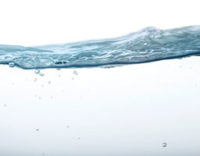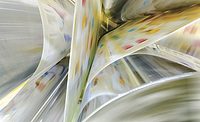The late 1980s and early 1990s started to show a substantial increase in the desire for UV-curable coatings. Not only was it a matter of application speed but it also provided another option for ecologically beneficial coatings in addition to waterborne. Resin manufacturers really started to put a focus on high-quality resins for topcoat systems.
The following are some of the benefits that have been espoused by 100% non-volatile matter (NVM) UV-curable resins.
Low Levels of VOC
The 100% NVM UV-curable resins can be coupled with low-viscosity 100% NVM UV-curable monomers in order to create minimal- to no-solvent coatings.Instantaneous and Exceptional Properties
Physical properties of a coating are developed almost as quickly as the speed of manufacturing. Once a panel or substrate is cooled, the product is within 98% of its complete array of physical and chemical properties. This is not only advantageous within the formulation setting, but it also is beneficial for facilities with less-than-perfect manufacturing conditions.
The chemical resistance and physical properties are premium for a coating system that cures so fast. Even though UV-curable systems are 1K systems, they can resist laboratory chemicals (acids and bases) almost perfectly.

Cost-Effective Replacement
Once given an opportunity to perform, a UV-curable system will do so at an economical rate, even though the initial sticker shock on the price of a UV-curable coating can overwhelm an end user. The reasoning behind this is based on coverage. A 100% NVM UV-curable system will cover 1600 square feet per gallon, whereas a solventborne coating cannot cover the same amount of substrate due to a lower solids content.Added Benefits of Waterborne UV
There are certain limitations inherent in 100% NVM UV-curable resins and coatings that can be addressed by waterborne UV-curable systems.
Liquid Phase Benefits of Waterborne UV
Low Susceptibility to Irritation
Conventional UV-curable resins have a moderate to high degree of irritation to skin. This consideration is of much lower concern with regard to waterborne UV resins. Not only are waterborne resins primarily water but, in addition, they are also composed of high-molecular-weight monomers, which tend to be less harmful to a person's skin. The molecular weights of our polymers are well above 5000 daltons, which renders most of our resins as "low-concern" products.Water as a Monomer
Water has a great number of advantages for coatings systems. This carries over into waterborne UV as well. It is a cost-effective component of the coatings system, and is also non-hazardous. Water will also evaporate after penetrating into the substrate (wood, concrete, porous substrates), whereas conventional UV monomers can become trapped after curing and then try to leach out. Water allows for greater ease of cleanup as well.Ease of Formulation
The benefits of conventional waterborne systems have crossed the line into UV-curable systems. No longer is it nearly impossible to obtain a matte finish without the addition of over 5% flattening agent. Viscosity and rheology modification are easily manipulated. And conventional waterborne additives can be used to achieve wetting, flow, slip, blocking and defoaming.Application Phase Benefits of Waterborne UV
Physical Dry and Three-Dimensional Spray
The majority of the products within the Alberdingk Boley waterborne UV-curable product line are not emulsified UV-curable resins; therefore, these materials have the ability to physically dry before UV cure. These products will dry like conventional waterborne resins; they simply can be cured with UV light. The added benefits of the "physical drying" phenomenon are: substrate evaluation and repair prior to cure, sanding between coats without curing, and for clear coats, multiple coatings can be cured with one pass through the curing unit. If necessary, parts can be handled without causing defects to the coating (fingerprints) or transmission of the coating to the person.
Due to the ease of rheology modification, waterborne UV-curable resins can be utilized in the difficult-to-coat application scenarios, i.e., vertical and 3-dimensional.
Cured Phase Benefits from Waterborne UV
Lacquer-Like Appearance
One major disadvantage of 100% NVM resins is how the product looks on porous wood substrates. Due to rising ecological restrictions on coatings manufacturers, it is no longer as simple as adding solvent to a system to achieve this desired appearance. Now, with waterborne UV-curable resins, manufacturers can once again get a lacquer-like appearance that is desired by many mid- to high-end furniture manufacturers.Soft-Feel
In 100% NVM UV-curable coatings, the only way to attempt to achieve a soft-feel response is through the use of additives. However, with the advent of waterborne UV-curable coatings, the opportunity to achieve this type of tactile response is inherent in some resin systems. Alberdingk Boley has developed waterborne UV-curable systems based on its knowledge in conventional waterborne polyurethane soft-feel chemistry. These products are fully cured yet exhibit a ‘soft-feel' that rivals most conventional coatings.
Dual Curing Mechanism
Waterborne UV-curable resins can be enhanced in the curing system not only by choice of photoinitiator but also by incorporating a polyisocyanate. Polyisocyanates can be added to the system for increased resistance and physical properties.
Uniform Appearance
Waterborne UV-curable systems tend to have a more even appearance in the topcoat versus a 100% NVM UV-curable coating. Flattening agents seem to align in a more aesthetic presentation.
Adhesion to Difficult Substrates
Adhesion to difficult substrates can sometimes be overcome by the use of a waterborne UV-curable system instead of a 100% NVM UV-curable system. This is due to a couple of factors:
- 1) If the substrate is porous, then the waterborne system can penetrate to depths below the surface and form a film either through physical drying or irradiation. This allows for an anchoring effect.
2) Waterborne UV-curable systems will tend to shrink less upon curing. This puts less stress on the physical properties of the film and allows for sustained adhesion.
Types of Dispersions
Polyurethane (Aliphatic)Hard polyurethane resins will provide abrasion, chemical and scratch resistance while maintaining their elasticity. Flexible polyurethane resins are used for exterior applications due to their yellowing and water resistance. Soft-feel polyurethane resins have excellent flexibility, elongation and inherent low gloss.
Acrylic
This class of resins provides the best cost-performance balance. These resins provide blocking and yellowing resistance as well as coffee and water resistance.
Polyurethane (Aliphatic)/Acrylic Copolymers
These blends and copolymers provide for good properties from both families of resins while being more cost effective than straight polyurethanes.
Waterborne UV-Curable Dispersion
Example: LUX 440Resin Phase
Alberdingk LUX 440 is an acrylic-polyurethane copolymer combination that physically dries. The primary purpose in developing this product was for wood coatings with excellent physical and chemical properties. Table 1 outlines some of the features and properties of this product in the resin phase.
Formulated Phase
Table 2 contains a starting-point formula using the LUX 440. Table 3 contains the physical properties of the formulation contained in Table 2.This coating was drawn down on a piece of maple veneer using a 6-mil draw down bar. For each coat, the product was given 2 minutes at room temperature prior to 10 minutes at 50 deg C. After drying, each coat was cured using a Mercury bulb and run twice for a total of 1000 mJ/cm2.
Table 4 outlines the tests performed and the results achieved on the maple-veneer panel.






